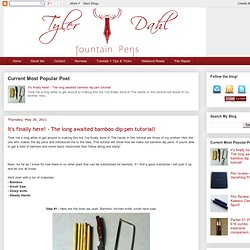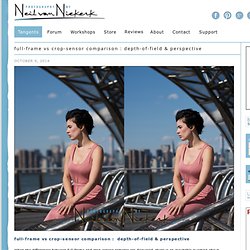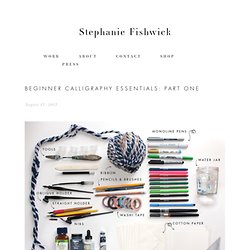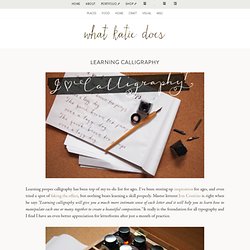

Whats-in-a-Calligraphy-Kit. Australian Society of Calligraphers. Tyler Dahl: It's finally here! - The long awaited bamboo dip pen tutorial! Took me a long while to get around to making this but I've finally done it!

The hands in this tutorial are those of my brother. He's the one who makes the dip pens and introduced me to the idea. This tutorial will show how we make our bamboo dip pens. If you're able to get a hold of bamboo and some basic hand-tools then follow along and enjoy! Note: As far as I know for now there is no other plant that can be substituted for bamboo. We'll start with a list of materials:- Bamboo- Small Saw- Sharp knife- Steady Hands Step #1 - Here are the tools we used. Here's what we're after. Step #2 - Start by cutting a section of bamboo with the saw. Notice that we're cutting of the ring on the bamboo. Here's a section. Step #3 - Once again, exercise care and go slowlt so you don't wind up with a missing finger... Step #4 - Next step is to begin carving the bamboo. This is what we're after in the above step.
You'll now notice how wide the tip is. Step #7 - All finished! Underside of the nib. Regards, HoustonCalligraphy. Lessons in Calligraphy and Penmanship. Full-frame vs crop-sensor comparison : depth-of-field & perspective. When the differences between full-frame and crop-sensor cameras are discussed, there is an inevitable question about whether the crop sensor multiplies the focal length.

Whether a 50mm lens on a crop-sensor acts like a 75mm lens (on a 1.5x crop sensor) or 80mm lens (on a 1.6x crop sensor). The answers given on the photography forums are confusing – yes, the focal length effectively increases. No, it doesn’t. Two polar opposite answers. The discussion (which tend to devolve into arguments) are convincingly made for both sides. One argument goes along the lines that the crop sensor is just that, a crop. With this article, I want to help analyze what happens when you change lenses between a full-frame camera and a crop-sensor camera.
Since this article ended up being a long meandering discussion, I thought it best that we start with the final summary. Summary: But let’s discuss this with some images: notes on depth-of-field / DoF shallow depth of field is NOT the same as bokeh. 1. Beginner Calligraphy Essentials: Part One — Stephanie Fishwick. When I started doing calligraphy I had no guide to follow for procuring the right materials to even see if I liked it!

It is surprisingly hard to figure all of this out without taking a class with a reputable calligraphy guild or experienced penman. There are also few guides online that pertain to the pointed pen. I thought that I could head up to the local art store and that it would be a pretty straightforward purchase of the supplies. Learning Calligraphy : What Katie Does.
Learning proper calligraphy has been top of my to-do list for ages.

I’ve been storing up inspiration for ages, and even tried a spot of faking the effect, but nothing beats learning a skill properly. Master letterer Jon Contino is right when he says “Learning calligraphy will give you a much more intimate sense of each letter and it will help you to learn how to manipulate each one or many together to create a beautiful composition.” It really is the foundation for all typography and I find I have an even better appreciation for letterforms after just a month of practice. Josh bought me a nice Winsor and Newton set for Christmas, which was the kick that I needed to get started. I also signed up for American designer and letterer Melissa Esplin‘s online course, I Still Love Calligraphy, for extra guidance and encouragement. The online course has been very useful to this novice. I’ve had quite a few emails and comments asking how to get started, so here are my tips:
Nose tutorial by ryky on deviantART. Exploring Nature Educational Resource. Photography Tips & Tutorials.